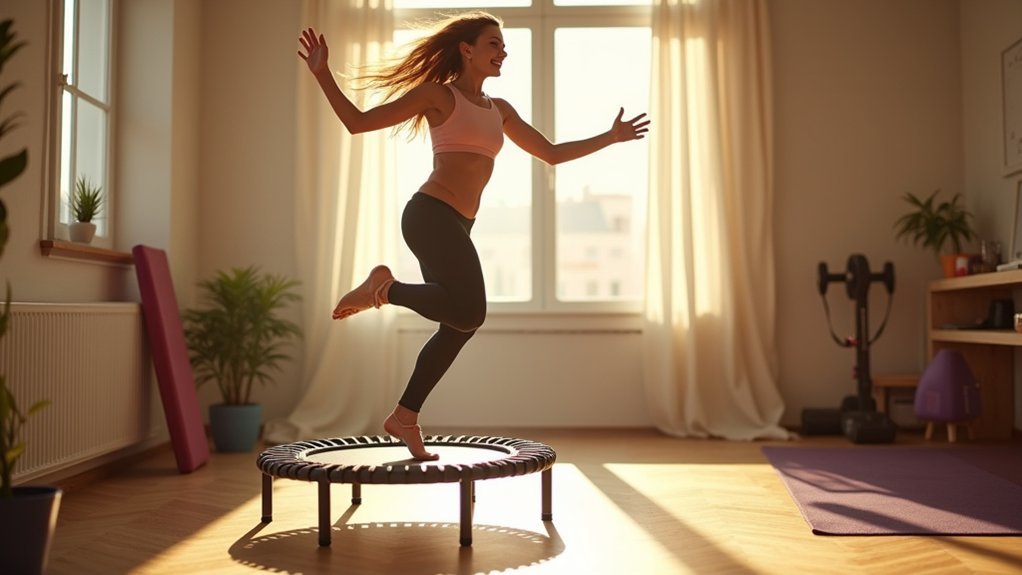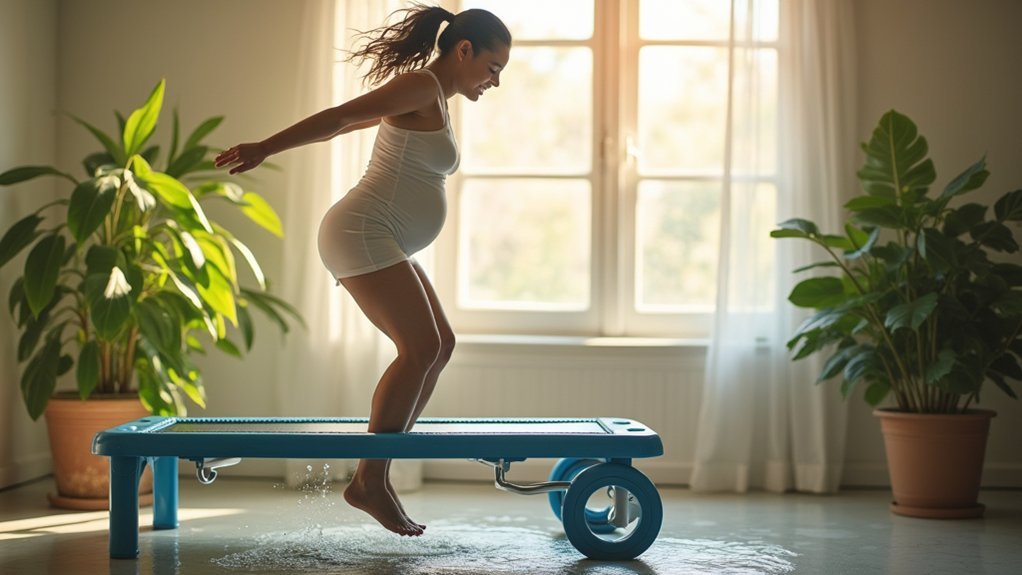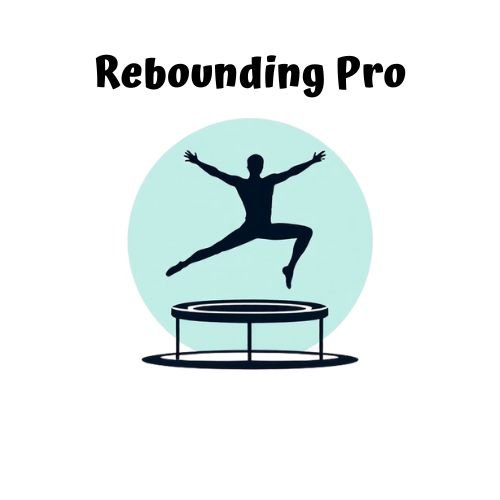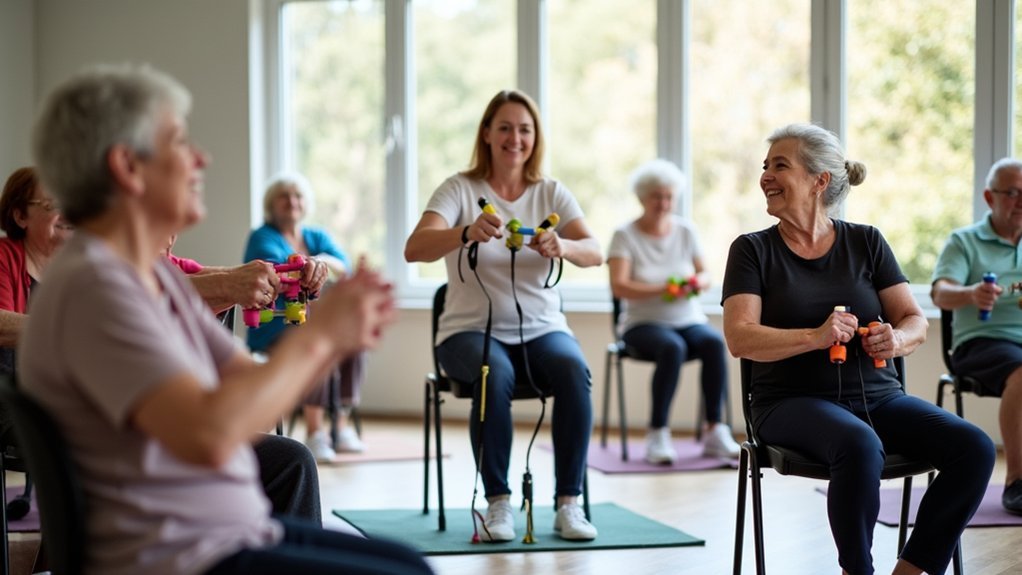Rebounding on a mini-trampoline helps shed postpartum weight by burning up to 600 calories hourly while protecting your healing joints. You’ll strengthen your pelvic floor, improve diastasis recti, and trigger a 24-hour metabolic afterburn effect. The low-impact bouncing activates multiple muscle groups simultaneously, boosts lymphatic drainage to reduce swelling, and fits into 15-minute nap-time windows. This time-efficient workout delivers the cardiovascular benefits of running in just one-third of the time. Discover how this gentle exercise transforms your postpartum recovery journey.
Low-Impact Cardio That Protects Recovering Joints

While your body heals from childbirth, rebounding offers the perfect balance of effective cardio without taxing your vulnerable joints. The mini-trampoline’s soft surface absorbs up to 87% of impact, creating a gentle environment for your postpartum body.
You’ll elevate your heart rate and burn up to 600 calories hourly without the jarring stress typical of traditional exercises. This makes rebounding an ideal weight loss solution when your body isn’t ready for high-impact activities.
The gentle bouncing motion improves circulation and lymphatic flow, helping your body flush excess fluids while building endurance.
Your recovering joints benefit from movement without pressure, allowing you to strengthen your cardiovascular system safely. As you bounce, you’re simultaneously protecting your healing body and creating the calorie deficit needed for effective postpartum weight loss.
Activates Multiple Muscle Groups Simultaneously
Your rebounding workout engages your core, legs, and arms all at once, creating an efficient full-body exercise that maximizes your time investment.
This simultaneous muscle activation greatly boosts your metabolic rate, helping you burn more calories during and after your session.
Efficient Total-Body Workout
Three major benefits make rebounding an ideal postpartum exercise: it engages multiple muscle groups at once, burns calories efficiently, and saves valuable time. When you bounce, your core, legs, and arms work simultaneously, creating a thorough workout that can help strengthen areas weakened during pregnancy and target stubborn weight gain.
Unlike traditional exercises that isolate specific muscles, rebounding maximizes your limited mommy time by working your entire body at once. Just 10 minutes on a rebounder delivers cardiovascular benefits equivalent to 30 minutes of running—without the joint strain.
Add variations like squats and arm movements to enhance your results even further. The enjoyable, rhythmic nature of rebounding often encourages longer sessions, meaning more calories burned while you’re having fun getting your pre-baby body back.
Boosts Metabolic Rate
When new moms struggle to shed postpartum weight, rebounding offers a metabolic powerhouse solution that conventional exercises can’t match. Each bounce activates your core, legs, and glutes simultaneously, cranking up calorie expenditure during your workout and long after you’ve finished.
Unlike high-impact exercises that stress your joints, rebounding delivers intense cardiovascular benefits while raising your heart rate and metabolic rate. Research confirms these aerobic workouts elevate your resting metabolism, helping you burn calories even while relaxing with your baby.
The rhythmic bouncing motion also stimulates your lymphatic system, enhancing detoxification and improving metabolic function.
At 400-800 calories burned per hour, rebounding transforms your postpartum body efficiently. You’ll maximize your limited workout time while your metabolism does the heavy lifting throughout the day.
Boosts Metabolism for 24-Hour Calorie Burning

Unlike traditional workouts that stop burning calories when you finish exercising, rebounding creates a metabolic afterburn effect that keeps working long after you’ve stepped off the trampoline. Your body continues burning calories for up to 24 hours post-workout, maximizing your weight loss efforts with minimal time investment.
| Time Spent | Calories Burned | Benefits |
|---|---|---|
| 10 minutes | ~50 calories | Quick energy boost |
| 20 minutes | ~100 calories | Improved circulation |
| 30 minutes | ~150 calories | Enhanced fat burning |
| 45 minutes | ~225 calories | Muscle toning effects |
| 60 minutes | ~300 calories | Maximum metabolic impact |
Just 10 minutes daily stimulates your metabolism while building muscle—crucial for postpartum recovery. As you’re bouncing, you’re creating both immediate calorie burn and setting up your body for extended energy expenditure throughout your day.
Strengthens Pelvic Floor Without Traditional Kegels
The gentle bouncing motion on a mini-trampoline automatically engages your pelvic floor muscles without a single conscious Kegel.
You’ll strengthen this vital postpartum area through the natural gravitational changes as you rebound, creating an effective workout that’s easier on your healing body than high-impact exercises.
The trampoline’s elastic surface provides just enough resistance to activate your pelvic floor while minimizing stress on your joints, making it an ideal solution for new moms seeking recovery.
Trampoline Effect
Most new moms struggle with pelvic floor weakness after childbirth, but rebounding offers a secret weapon for recovery. Unlike traditional Kegel exercises that can feel tedious and forgettable, the natural bouncing motion on a trampoline automatically engages your pelvic floor muscles.
Each bounce creates a unique gravitational pull that strengthens these vital muscles more effectively than static exercises. You’ll experience improved bladder control and reduced leakage as your pelvic floor responds to the gentle, consistent workout.
The up-and-down motion simultaneously builds core stability—essential for your overall pelvic health and postpartum recovery.
You’re not just strengthening your pelvic floor when you rebound; you’re also boosting cardiovascular fitness while having fun. It’s a win-win approach that turns necessary rehabilitation into an enjoyable part of your fitness routine.
Low-Impact Muscle Activation
Many postpartum women dread traditional Kegel exercises, but rebounding offers a rejuvenating alternative that engages your pelvic floor effortlessly. The gentle bouncing motion automatically activates these vital muscles while improving blood flow to your pelvic region, accelerating healing after childbirth.
| Rebounding Benefit | Pelvic Floor Impact |
|---|---|
| Gentle Activation | Automatically engages muscles without conscious effort |
| Core Stability | Strengthens supporting muscles around the pelvic floor |
| Increased Circulation | Promotes faster healing to damaged tissues |
| Adjustable Intensity | Allows gradual strengthening as you recover |
| Consistency | Helps reduce postpartum bladder leakage issues |
You’ll appreciate how rebounding lets you progressively increase intensity as your strength returns. This low-impact approach provides effective pelvic floor toning while you’re simultaneously burning calories and rebuilding your postpartum confidence.
Enhances Lymphatic Drainage to Reduce Postpartum Swelling

While your body is recovering from childbirth, excess fluid retention can leave you feeling bloated and uncomfortable.
Rebounding offers a powerful solution by stimulating your lymphatic system, which helps eliminate toxins and excess fluids contributing to that postpartum puffiness.
The gentle up-and-down motion on a mini-trampoline activates your lymphatic vessels, enabling more efficient drainage and reducing inflammation in swollen areas.
Just 10-15 minutes of daily bouncing greatly boosts lymphatic circulation, targeting fluid retention where you need it most.
What makes rebounding ideal for new moms is its low-impact nature – you’ll get effective lymphatic benefits without stressing your recovering joints.
This enhanced drainage not only reduces visible swelling but also supports your overall postpartum recovery process.
Creates Optimal Hormonal Balance for Fat Loss
Postpartum weight loss often stalls due to hormonal imbalances that linger after childbirth, but rebounding offers a natural solution to reset your body’s chemical messengers.
As you bounce, your body naturally regulates cortisol levels, helping reduce that stubborn belly fat that seems to cling after pregnancy.
The gentle bouncing motion doesn’t just burn calories—it triggers your body to produce growth hormone, which plays an essential role in fat metabolism while preserving the muscle you need.
You’ll also experience a natural boost in serotonin and dopamine, reducing stress-induced eating patterns that can sabotage your weight loss efforts.
Unlike high-impact workouts that might feel impossible right now, rebounding’s gentle nature allows you to exercise consistently, maintaining the hormonal balance necessary for effective postpartum weight loss.
Improves Core Stability While Protecting Diastasis Recti
After childbirth, your core muscles need careful rehabilitation, which is precisely why rebounding stands out as an ideal exercise for new moms with diastasis recti. The gentle bouncing motion engages your deep abdominal muscles without putting excessive strain on your separated abdomen.
| Rebounding Benefit | Impact on Diastasis Recti | How It Helps |
|---|---|---|
| Low-Impact Nature | Minimizes pelvic floor strain | Prevents worsening separation |
| Core Engagement | Activates stabilizing muscles | Supports muscle reconnection |
| Improved Posture | Enhances overall alignment | Reduces pressure on weakened areas |
| Balance Training | Recruits supporting muscles | Strengthens entire core system |
| Fun Factor | Increases workout consistency | Accelerates recovery process |
You’ll notice improved coordination and stability as you bounce, which translates directly to better posture and core function during daily mom activities—all while your body heals naturally.
Time-Efficient Workouts for Busy New Moms
Finding time to exercise with a newborn can seem nearly impossible, but that’s where rebounding truly shines for new moms. You can complete an effective rebounding session in just 15-20 minutes, fitting it perfectly into those precious moments when your baby naps.
These quick workouts pack impressive benefits, burning around 300 calories per hour while remaining gentle on your recovering body. Add resistance movements during your bouncing routine to maximize muscle toning and strength in minimal time.
The rhythmic motion doesn’t just shape your body—it boosts your mood and energy levels too, combating the fatigue that comes with new motherhood.
You’ll strengthen your core and pelvic floor simultaneously, addressing key postpartum recovery needs without sacrificing your limited time.
Progressive Intensity Options for Every Recovery Stage
Your postpartum rebound journey can start with gentle, beginner-friendly bounce sessions that build core strength while respecting your body’s healing process.
As your recovery progresses, you’ll shift to more dynamic movements like the running man or ballerina cross that engage multiple muscle groups simultaneously.
When you’re ready for maximum calorie burn, incorporate advanced rebound intervals with squats and single-leg exercises that accelerate your results while maintaining proper form and pelvic stability.
Beginner-Friendly Bounce Sessions
While your body heals from childbirth, gentle movement on a rebounder can jumpstart your postpartum fitness journey without overwhelming your recovering system.
Start with basic bounces, keeping your feet on the mat while gently bending your knees to create a subtle bouncing motion. As you gain confidence, incorporate simple arm movements to increase calorie burn.
Try lifting one leg while maintaining balance to engage your core muscles – essential for rebuilding abdominal strength after pregnancy. These low-impact exercises are perfect for joint protection while still providing cardiovascular benefits.
Add side-to-side motions to work your waist and hips as your stamina improves. You’ll notice not just physical improvements but mood enhancement too – a welcome bonus during the emotional adjustments of early motherhood.
Advanced Rebound Intervals
Three months postpartum marks an ideal time to elevate your rebounding routine through strategic interval training.
You’ll maximize calorie burn while protecting your healing joints by alternating high-intensity movements like jumping jacks with quick footwork sequences.
Start with 30-second intervals—intense rebounding followed by recovery periods—then gradually increase duration as your endurance builds. Your body will respond quickly to these varying intensities, boosting cardiovascular fitness and accelerating weight loss.
For added challenge, incorporate resistance bands to target specific muscle groups weakened during pregnancy. This combination transforms your bounce session into an all-encompassing strength and cardio workout.
Remember to honor your body’s signals. If you feel pelvic pressure or discomfort, scale back intensity and rebuild gradually as your core stability improves.
Combines Stress Relief With Weight Management Benefits
Unlike many conventional workouts, rebounding offers new moms a powerful dual benefit of stress reduction and calorie burning in one efficient activity.
As you bounce, your body releases mood-boosting endorphins that combat postpartum anxiety while simultaneously burning 200-300 calories in just 30 minutes.
This low-impact exercise is perfectly suited for your recovering body, minimizing joint stress while maximizing caloric output.
You’ll feel the emotional lift almost immediately as the rhythmic bouncing motion triggers your body’s natural stress-fighting response.
What makes rebounding particularly valuable postpartum is how it addresses both physical and emotional recovery simultaneously.
While you’re strengthening your core and supporting weight management goals, you’re also giving your mental health the attention it deserves during this demanding adjustment period.
Frequently Asked Questions
What Is the Fastest Way to Lose Weight After Pregnancy?
You’ll lose weight fastest after pregnancy through gradual methods—combine low-impact cardio with strength training, maintain a breastfeeding-friendly diet, stay hydrated, and prioritize sleep. Don’t rush; aim for healthy, sustainable progress.
Is Rebounding Good for Post Partum?
Yes, rebounding is excellent for postpartum recovery. You’ll enjoy its low-impact nature that’s gentle on your joints while it strengthens your core, boosts your mood, and helps shed baby weight with minimal stress.
What Is the 5 5 5 Rule Postpartum?
The 5 5 5 rule postpartum suggests you spend 5 minutes rebounding, 5 minutes strengthening, and 5 minutes stretching daily. It’s designed to help you recover gradually while establishing a manageable fitness routine after childbirth.
Is It Normal to Lose 20 Pounds in 1 Week Postpartum?
No, losing 20 pounds in one week postpartum isn’t normal. You’ll typically lose 10-15 pounds initially from baby, placenta, and fluids. Further weight loss should be gradual. Consult your doctor about healthy expectations.
In Summary
You’re now equipped to transform your postpartum journey through rebounding! This versatile exercise isn’t just about weight loss—it’s strengthening your core, protecting your recovering body, and fitting into your busy mom schedule. Whether you’re just starting or ready for intensity, rebounding offers a sustainable path forward. You’ll enjoy both physical results and mental clarity as you bounce your way back to feeling like yourself again.





Leave a Reply